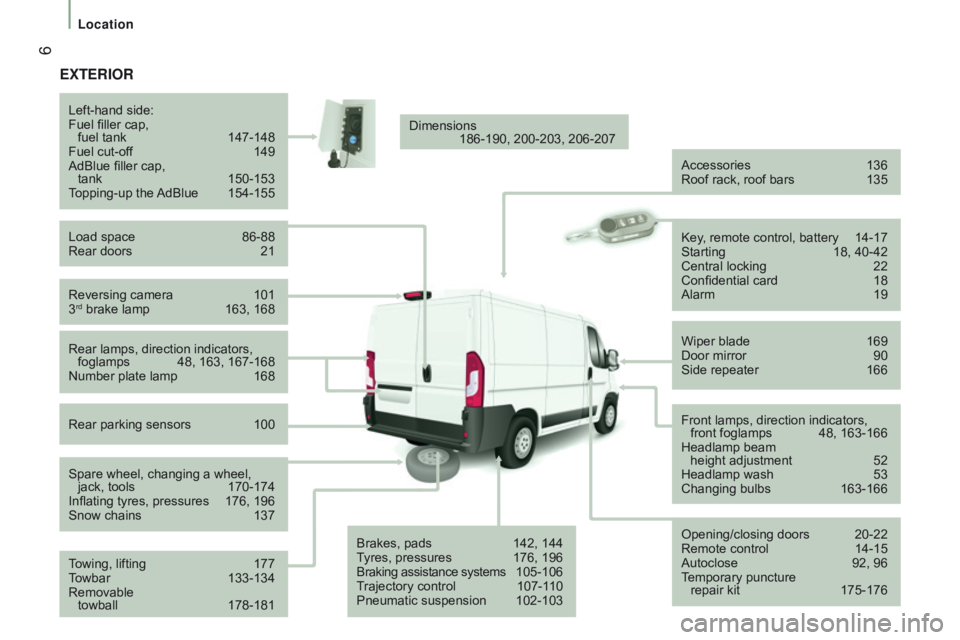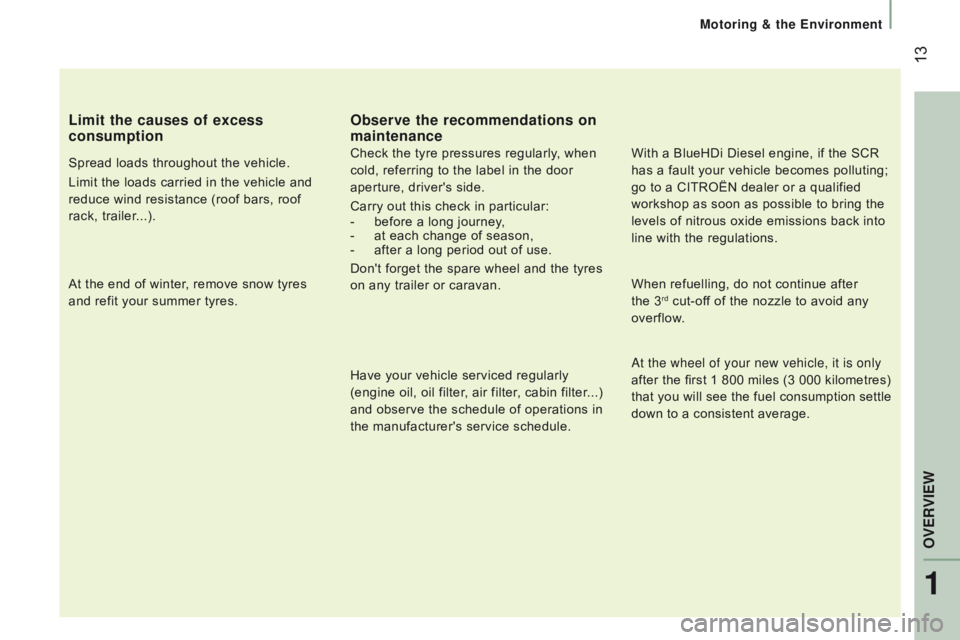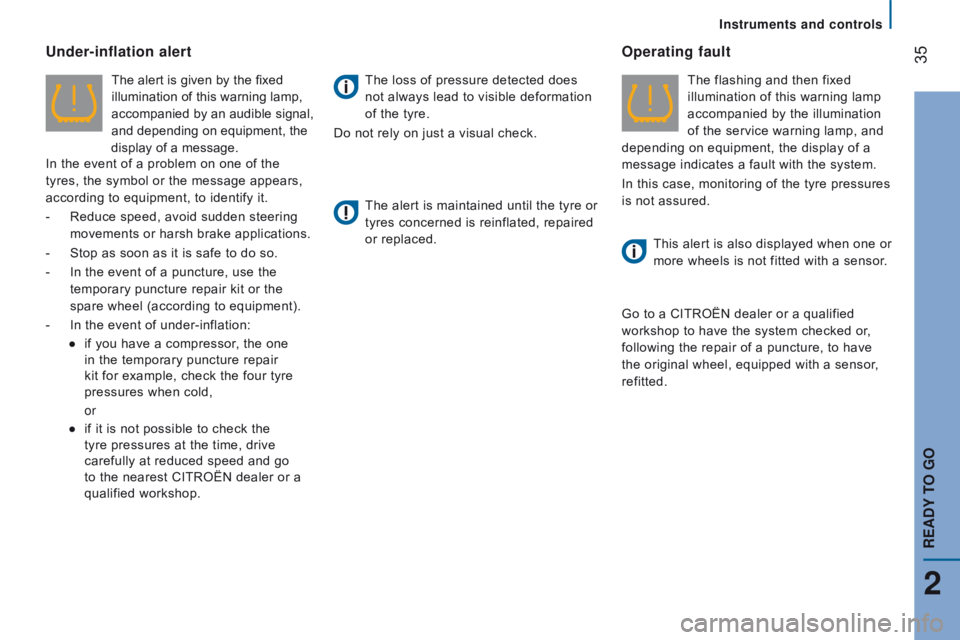spare wheel CITROEN RELAY 2017 Handbook (in English)
[x] Cancel search | Manufacturer: CITROEN, Model Year: 2017, Model line: RELAY, Model: CITROEN RELAY 2017Pages: 292, PDF Size: 9.04 MB
Page 8 of 292

6
ExtErIOr
Reversing camera 101
3rd brake lamp 163, 168
Left-hand side:
Fuel filler cap,
fuel tank
147-148
Fuel cut-of
f
149
AdBlue filler cap,
tank
150-153
T
opping-up the AdBlue
154-155
Load space
86-88
Rear doors
21
Rear lamps, direction indicators, foglamps
48, 163, 167-168
Number plate lamp
168
Rear parking sensors
100
Spare wheel, changing a wheel, jack, tools
170-174
Inflating tyres, pressures
176, 196
Snow chains
137
T
owing, lifting
177
T
owbar
133-134
Removable
towball
178-181 Dimensions
186-190, 20
0-203, 206-207
Accessories
136
Roof rack, roof bars
135
Brakes, pads
142, 144
T
yres, pressures
176, 196
Braking assistance systems
1
05-106
Trajectory control
107-1
10
Pneumatic suspension
102-103Key
, remote control, battery
14-17
Starting
18, 40-42
Central locking
22
Confidential card
18
Alarm
19
Wiper blade
169
Door mirror
90
Side repeater
166
Opening/closing doors
20-22
Remote control
14-15
Autoclose
92, 96
T
emporary puncture
repair kit
175-176
Front lamps, direction indicators,
front foglamps
48, 163-166
Headlamp beam
height adjustment
52
Headlamp wash
53
Changing bulbs
163-166
Location
Page 15 of 292

13
Limit the causes of excess
consumption
Spread loads throughout the vehicle.
Limit the loads carried in the vehicle and
reduce wind resistance (roof bars, roof
rack, trailer...).
At the end of winter, remove snow tyres
and refit your summer tyres.
Observe the recommendations on
maintenance
Check the tyre pressures regularly, when
cold, referring to the label in the door
aperture, driver's side.
Carry out this check in particular:
-
before a long journey
,
-
at each change of season,
-
after a long period out of use.
Don't forget the spare wheel and the tyres
on any trailer or caravan.
Have your vehicle serviced regularly
(engine oil, oil filter, air filter, cabin filter...)
and observe the schedule of operations in
the manufacturer's service schedule. With a BlueHDi Diesel engine, if the SCR
has a fault your vehicle becomes polluting;
go to a CITROËN dealer or a qualified
workshop as soon as possible to bring the
levels of nitrous oxide emissions back into
line with the regulations.
When refuelling, do not continue after
the 3
rd cut-off of the nozzle to avoid any
overflow.
At the wheel of your new vehicle, it is only
after the first 1 800 miles (3 000 kilometres)
that you will see the fuel consumption settle
down to a consistent average.
1
OVErVIEW
Motoring & the Environment
Page 36 of 292

34EMISSIOnS cOntrOLS
EOBD (European On Board Diagnosis) is
a diagnostics system which complies with,
among others, the standards on emissions
limits of:
-
CO (carbon monoxide),
-
HC (unburnt hydrocarbons),
-
NOx (nitrogen oxides), detected by
oxygen sensors placed downstream of
the catalytic converters,
-
particles.
tYrE undEr-InFLAt IO n d E t E ct IO n
System which automatically checks the
pressures of the tyres while driving.
The tyre under-inflation detection
system is an aid to driving which does
not replace the need for vigilance on
the part of the driver. This system does not avoid the need
to check the tyre pressures regularly
(including the spare wheel) and before a
long journey.
Driving with under-inflated tyres increases
fuel consumption.
The system continuously monitors the
pressures of the four tyres, as soon as the
vehicle is moving.
A pressure sensor is located in the valve of
each tyre.
The system triggers an alert if a drop in
pressure is detected in one or more tyres. The tyre pressures must be checked
when the tyres cold (vehicle stopped
for 1 hour or after driving for less then
6 miles (10 km) at moderate speed).
Otherwise, add 0.3 bar to the values
indicated on the label.
The tyre pressures for your vehicle can be
found on the tyre pressure label.
The driver is warned of any
malfunction of this emissions
control system by the illumination
of this warning lamp in the
instrument panel.
If this warning lamp comes on, have it
checked by a CITROËN dealer or a qualified
workshop.
To locate it, refer to the "Technical
data
- Identification markings" section.
Driving with under-inflated tyres
adversely affects road holding, extends
braking distances and causes premature
tyre wear, particularly under arduous
conditions (vehicle loaded, high speed, long
journey).
Instruments and controls
Page 37 of 292

35under-inflation alert
The alert is given by the fixed
illumination of this warning lamp,
accompanied by an audible signal,
and depending on equipment, the
display of a message.
In the event of a problem on one of the
tyres, the symbol or the message appears,
according to equipment, to identify it.
-
Reduce speed, avoid sudden steering
movements or harsh brake applications.
-
Stop as soon as it is safe to do so.
-
In the event of a puncture, use the
temporary puncture repair kit or the
spare wheel (according to equipment).
-
In the event of under-inflation:
●
if you have a compressor
, the one
in the temporary puncture repair
kit for example, check the four tyre
pressures when cold,
or
●
if it is not possible to check the
tyre pressures at the time, drive
carefully at reduced speed and go
to the nearest CITROËN dealer or a
qualified workshop. The loss of pressure detected does
not always lead to visible deformation
of the tyre.
Do not rely on just a visual check.
The alert is maintained until the tyre or
tyres concerned is reinflated, repaired
or replaced.
Operating fault
The flashing and then fixed
illumination of this warning lamp
accompanied by the illumination
of the service warning lamp, and
depending on equipment, the display of a
message indicates a fault with the system.
In this case, monitoring of the tyre pressures
is not assured.
This alert is also displayed when one or
more wheels is not fitted with a sensor.
Go to a CITROËN dealer or a qualified
workshop
to have the system checked or,
following the repair of a puncture, to have
the original wheel, equipped with a sensor,
refitted.
2
rEAdY tO GO
Instruments and controls
Page 139 of 292

137
SnOW cHAInS
In wintry conditions, snow chains improve
traction as well as the behaviour of the
vehicle when braking.The snow chains must be fitted only to
the driving wheels. They must never be
fitted to "space-saver" type spare wheels.
Take account of the legislation in force
in your country on the use of snow
chains and the maximum running speed
authorised. Advice on installation
F
If you have to fit the chains during
a journey, stop the vehicle on a flat
surface on the side of the road.
F
Apply
the parking brake and position any
wheel chocks to prevent movement of
your vehicle.
F
Fit the chains following the instructions
provided by the manufacturer.
F
Move of
f gently and drive for a few
moments, without exceeding 30 mph
(50
km/h).
F
Stop your vehicle and check that the
snow chains are correctly tightened.
It is recommended that before you
leave, you practise fitting the snow
chains on a level and dry surface. Avoid driving with chains on roads that
have been cleared of snow, to avoid
damaging your vehicle's tyres and the road
surface. If your vehicle is fitted with alloy
wheels, check that no part of the chain or its
fixings is in contact with the wheel rim.
Use only the chains designed to be fitted to
the type of wheel fitted to your vehicle:
Original tyre size Maximum link size.215/70 R15 12 mm
225/75 R15 16 mm
215/75 R16 16 mm
225/75 R16 16 mm
For more information on snow chains,
contact a CITROËN dealer or a qualified
workshop.
6
AccESSOrIES
Equipment
Page 173 of 292

171
● For versions with alloy wheels, remove
the three fixing screws j
from the
strap
K.
●
Remove the assembly from inside the
alloy wheel.
Spare wheel
The spare wheel retaining bolt is located
below the bumper on the right.
-
Install the long socket
A, the
wheelbrace
d
and the bar
B on the
retaining bolt.
-
T
urn the assembly anti-clockwise to
lower the wheel.
-
T
urn to the full extent, indicated by an
increase in the force required.
-
Having fully unwound the cable, take out
the spare wheel under the vehicle. ●
For versions with steel wheels, unscrew
the grip H .
●
Remove the carrier
I from the outer part
of the steel wheel.
-
Release the spare wheel and place it
near the wheel to be changed.
-
If possible, place a chock against the
wheel diagonally opposed to the wheel
to be changed.
QuIcK HELP
8
Puncture
Page 175 of 292

173
Fitting the spare wheelStowing the wheel
- Put the spare wheel in place on the hub
and fit the bolts by hand.
-
Pre-tighten the bolts using the
wheelbrace
d and the bar
B.
-
Lower the vehicle completely by folding
the jack
c
, then remove the jack.
-
T
ighten the bolts again using the
wheelbrace
d and the bar
B (tighten
them fully without forcing them). You must place the wheel to be repaired or
the spare wheel under the vehicle to secure
the carrier system.
-
Place the wheel at the rear of the vehicle.
●
For versions with
steel wheels, hook
the carrier I on the outside.
●
Screw in the grip
H to secure the carrier
and wheel. ●
For versions with alloy wheels, position
the strap K on the outside.
●
Fit the three strap fixing screws
j
to the
alloy wheel.
QuIcK HELP
8
Puncture
Page 176 of 292

174
Refer to the "Technical data -
Identification markings" section for the
location of the tyre pressure label.
-
Fit the long socket
A
, the wheelbrace
d
and bar B to the securing screw.
-
T
urn the assembly clockwise to fully
draw in the cable and raise the wheel
under the vehicle.
-
Check that the wheel is positioned
horizontally flat against the floor of
the vehicle and that the cut-out for the
carrier system is visible.
-
Stow the tools and the trim (depending
on version).
refitting the repaired wheel
Refitting the repaired wheel is the same as
fitting the spare wheel; don't forget to refit
the wheel trim.
The spare wheel is not designed to be used
over long distances. Have the tightening of
the bolts and pressure of the spare wheel
checked by a CITROËN dealer or a qualified
workshop without delay.
Also, have the original wheel repaired and
refitted by a CITROËN dealer or a qualified
workshop as soon as possible.
Puncture